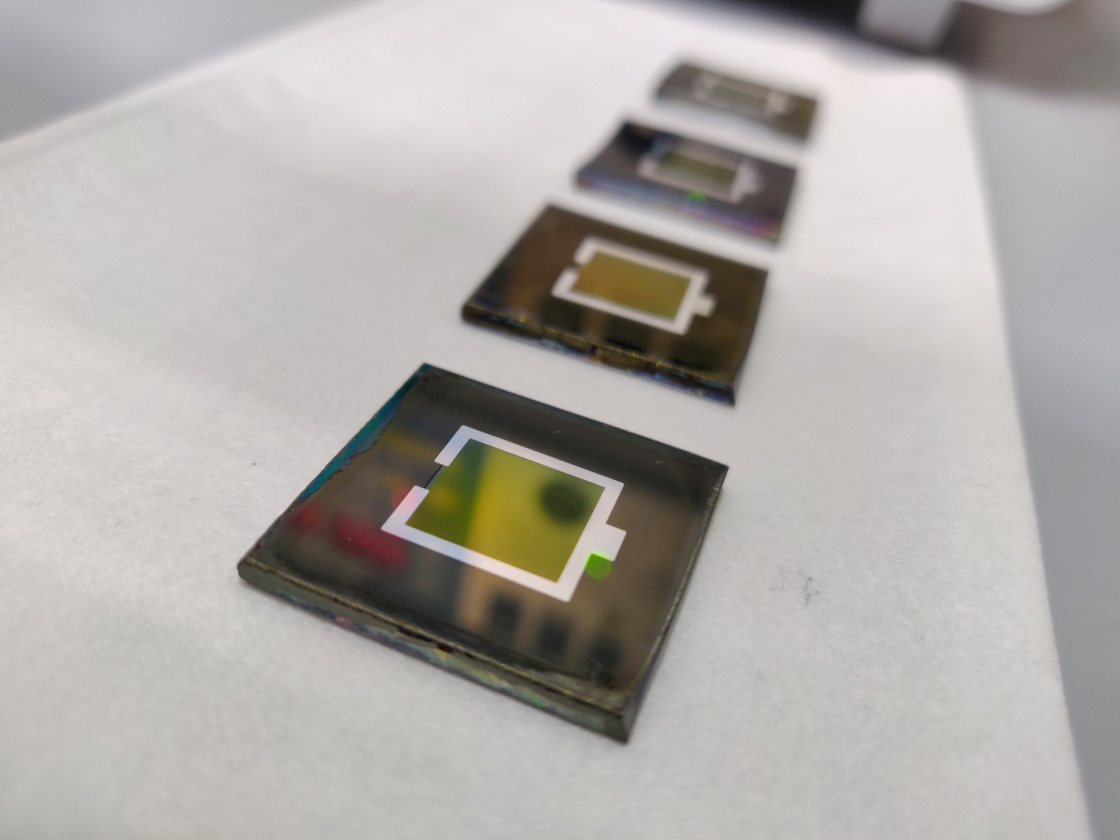Department Perovskite Tandem Solar Cells
Department Perovskite Tandem Solar Cells
The focus of our group is to develop highly efficient perovskite tandem solar cells. These employ metal halide perovskite absorbers, a novel material with excellent optoelectronic properties, a tunable bandgap and a promising low-cost fabrication. In combination with a second absorber in so-called tandem solar cells, a significant improvement in solar cell efficiency can be realized, above the limit of single-junction solar cells. Our multidisciplinary group investigates the different optical and electrical loss mechanisms to improve the performance of these cells. For this, our group uses the infrastructure of the HySPRINT Photovoltaics Lab and collaborates internationally with other groups as well as industrial partners.
In the past years, we achieved several advances and independently certified world record tandem solar cells in the field of perovskite tandem solar cells. In collaboration with Kaunas University, we developed self-assembled monolayers which act as hole-selective layers with extremely low non-radiative recombination losses and excellent charge-extraction properties. Furthermore, we achieved a perovskite-silicon tandem solar cell with a certified power conversion efficiency of 29.15% [1] and a perovskite-CIGS tandem solar cell with a certified power conversion efficiency of 24.16% [2].

Perovskites – A Promising Solar Cell Material
Since the first experimental realization of a perovskite solar cell in 2009, the efficiency of perovskite solar cells has increased fivefold, reaching power conversion efficiencies >25% today within an unprecedentedly fast development. Such high efficiencies can be obtained due to the excellent optoelectronic properties of perovskites. Moreover, perovskite layers can be fabricated rather easily and potentially cost-efficient via scalable solution-based (e.g., slot-die coating, inkjet-printing) and vapor-based (e.g., thermal evaporation) fabrication. The persisting challenges for perovskite solar cells revolve around their photovoltaic performance, temporal and chemical stability as well as scalability.
Tandem Solar Cells – Striving for Efficiencies >30%
To enable cost reduction in photovoltaics by increasing the efficiency of solar cells in the future, intensive research is carried out on alternatives. Its advantageous properties make perovskite photovoltaics interesting to be combined with silicon or other photovoltaic absorber materials in so-called tandem solar cells. In such devices, the wide bandgap material (in this case perovskite) absorbs the higher-energy visible light and converts it to electrical power whereas the lower bandgap material (i.e., silicon) absorbs the near-infrared light. This allows a more efficient conversion of a wide range of the solar spectrum into electrical energy, due to less losses into heat. Efficiencies >34% are targeted for the combination of perovskite-based solar cells with suitable bottom cell materials, which can significantly lower the levelized cost of solar electricity, making this technology a promising contributor for a transition towards a carbon neutral economy.
Development of Highly Efficient Perovskite Tandem Solar Cells
In our group, we investigate different aspects of perovskite tandem solar cells to achieve high efficiencies and develop technologies that are applicable to industrial applications. For this, we address optical and electrical loss mechanisms to improve the efficiencies of the tandems. This is achieved by a thoughtful selection of materials and tuning of their properties. Further activities focus on the upscaling of fabrication processes to close the gap to industrial applications. For more details on our different research fields, please read the more detailed descriptions below.
Development of New Contact Materials
A major factor for highly efficient solar cells are charge-selective layers, tailored to reduce electrical and optical losses [read more].
Tailoring Perovskite Properties
The optoelectronic properties of perovskite absorbers need to be adjusted to application in different tandem architectures [read more] .
High-Efficiency Multi-Junction Concepts
The core goal of our group is to develop different high-efficiency tandem solar cells, combining different absorber materials and investigating novel device concepts [read more].
Reducing Optical Losses
For highly efficient perovskite tandem solar cells, optical losses must be minimized by employing suitable materials and neat light management concepts [read more].

Multiple Perovskite/CIGSe Tandem Solar Cells. Picture: A. Al-Ashouri / HZB

Impression of HySPRINT-Lab. Picure: E. Köhnen / HZB
Stability
Although perovskite-based tandem photovoltaics have achieved unprecedented progress, long-term operational stability of perovskite photovoltaics is still a challenge for perovskite-based tandem photovoltaics [read more].
Upscaling for Industrial Applications
For the realization of industrial-scale perovskite-based solar cells, it is mandatory to increase the device area [read more].
Characterization and Analytics
To achieve highly efficient tandem solar cells, a good understanding of their specific properties is required, which can be gained with advanced characterization and analytics [read more].
Key Publications:
- Al-Ashouri, A.; Köhnen, E.; Bor, L.; Magomedov, A.; Hempel, H.; Caprioglio, P.; Márquez, J.; Morales Vilches, A.B.; Kasparavicius, E.; Smith, J.A.; Phung, N.; Menzel, D.; Grischek, M.; Kegelmann, L.; Skroblin, D.; Gollwitzer, C.; Malinauskas, T.; Jošt, M.; Matic, G.; Rech, B.; Schlatmann, R.; Topic, M.; Korte, L.; Abate, A.; Stannowski, B.; Neher, D.; Stolterfoht, M.; Unold, T.; Getautis, V.; Albrecht, S.: Monolithic perovskite/silicon tandem solar cell with >29% efficiency by enhanced hole extraction. Science 370 (2020), p. 1300-1309
doi:10.1126/science.abd4016
Open Access Version (available 01.12.2021)
(available 01.12.2021) - Al-Ashouri, A.; Magomedov, A.; Roß, M.; Jost, M.; Talaikis, M.; Chistiakova, G.; Bertram, T.; Márquez, J.A.; Köhnen, E.; Kasparavicius, E.; Levcenco, S.; Gil-Escrig, L.; Hages, C.; Schlatmann, R.; Rech, B.; Malinauskas, T.; Unold, T.; Kaufmann, C.A.; Korte, L.; Niaura, G.; Getautis, V.; Albrecht, S.: Conformal monolayer contacts with lossless interfaces for perovskite single junction and monolithic tandem solar cells. Energy & Environmental Science 12 (2019), p. 3356-3369
- Tockhorn, P.; Sutter, J.; Cruz, A.; Wagner, P.; Jäger, K.; Yoo, D.; Lang, F.; Grischek, M.; Li, B.; Li, J.; Shargaieva, O.; Unger, E.; Al-Ashouri, A.; Köhnen, E.; Stolterfoht, M.; Neher, D.; Schlatmann, R.; Rech, B.; Stannowski, B.; Albrecht, S.; Becker, C.: Nano-optical designs for high-efficiency monolithic perovskite–silicon tandem solar cells. Nature Nanotechnology 17 (2022), p. 1214–1221
- Mariotti, S.; Köhnen, E.; Scheler, F.; Sveinbjörnsson, K.; Zimmermann, L.; Piot, M.; Yang, F.; Li, B.; Warby, J.; Musiienko, A.; Menzel, D.; Lang, F.; Keßler, S.; Levine, I.; Mantione, D.; Al-Ashouri, A.; Härtel, M.S.; Xu, K.; Cruz, A.; Kurpiers, J.; Wagner, P.; Köbler, H.; Li, J.; Magomedov, A.; Mecerreyes, D.; Unger, E.; Abate, A.; Stolterfoht, M.; Stannowski, B.; Schlatmann, R.; Korte, L.; Albrecht, S.: Interface engineering for high-performance, triple-halide perovskite–silicon tandem solar cells. Science 381 (2023), p. 63-69
